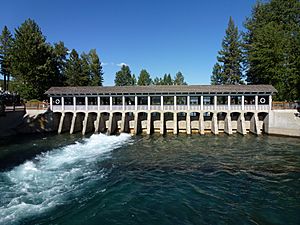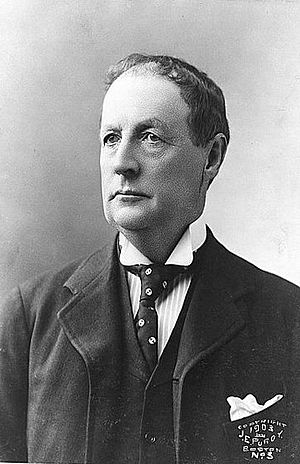Lake Tahoe Dam facts for kids
The Lake Tahoe Dam is a special wall built across the Truckee River in Placer County, California. It's located right where the water flows out of Lake Tahoe. This dam helps control how much water leaves Lake Tahoe.
The dam is in Tahoe City. It's a key part of something called the U.S. Bureau of Reclamation's Newlands Project. This project helps send water to farms in western Nevada. It provides water for about 55,000 acres (22,000 hectares) of farmland. The dam you see today replaced an older one built in 1870.
Workers built the current Lake Tahoe Dam between 1909 and 1913. It is about 18 feet (5.5 meters) tall and 109 feet (33 meters) long. It can raise Lake Tahoe's water level by up to 10 feet (3 meters). The dam has 17 gates that control the water flow. It can release a lot of water, up to 2,100 cubic feet (59 cubic meters) per second. The dam helps manage water levels, especially during dry times. It collects water from a large area of 505 square miles (1,308 square kilometers). It can store a huge amount of water, about 732,000 acre-feet (0.9 cubic kilometers).
Contents
History of the Dam
A Big Idea for Water
In 1892, a new politician from Nevada named Francis G. Newlands had a big idea. He wanted to bring more water to farms in the western United States. He believed this would help the country grow more food. Newlands had thought about this new water system since 1888. He even tried to start his own project, but it didn't work out.
However, his idea for more water helped him get elected to office. Real progress on his plan began in 1901 when Theodore Roosevelt became President. With President Roosevelt's support, Representative Newlands finally got his bill passed.
The Newlands Reclamation Act
On June 17, 1902, Congress passed the Newlands Reclamation Act. This law created the United States Bureau of Reclamation (USBR). This agency helps manage water resources in the U.S. The very first project from this new law was the Truckee–Carson Project. It was later renamed the Newlands Project, because Representative Newlands was so important to it.
Building for the Newlands Project started in 1903. They quickly built the Derby Dam and the Truckee Canal.
Taking Control of the Dam
In 1909, the Newlands Project wanted to own the Tahoe Dam. At that time, a company called Truckee River General Electric Company owned it. The US government finally bought the rights to the dam on June 4, 1915. They paid $139,500 for the dam and about 14 acres of land around it.
Before the government took over, both the electric company and the USBR helped rebuild the dam. They replaced the old wooden dam with a stronger concrete one. In 1987, the dam was updated again to make it safer against earthquakes. This updated version is the dam we see today.
The Newlands Project helped create many important water systems in Nevada and California. These include:
- Lake Tahoe Dam
- Lahontan Dam, its reservoir, and power plant
- Truckee Canal
- Carson River Diversion Dam
- Derby Diversion Dam
Protecting Fish: The Paiute Tribe Lawsuit
In 1987, the USBR planned to fix the Tahoe Dam to make it stronger against earthquakes. The Paiute Tribe saw this as a chance to speak up. They filed a lawsuit against the government. This case was called Pyramid Lake Paiute Tribe of Indians v. Secretary of the Interior Hodel.
The Paiute Tribe argued that the dam's operations were harming the endangered cui-ui fish in Pyramid Lake. Part of the Truckee River naturally flows into Pyramid Lake, which is on the Paiute Reservation. But the irrigation systems were taking too much water. This meant Pyramid Lake wasn't getting enough water for its plants and animals to live. It was found that the cui-ui fish were in danger because of low water levels.
On August 9, 1989, the court made a decision. It said that water would be stored in the Stampede Reservoir. This water would be released into Pyramid Lake when needed. This helped make up for the water lost to the irrigation systems of the Newlands Project.
A Local Landmark
Since it was built in the early 1900s, Tahoe Dam has become a well-known spot. It's a landmark for Tahoe City and the wider Tahoe-Truckee area. The dam was even recognized nationally. It was added to the National Register of Historic Places on March 25, 1981.
Another famous landmark near the dam is Fanny Bridge. This small two-lane bridge connects the North Shore and West Shore of Lake Tahoe. It's in Tahoe City, right across from the dam.




